What is climate?
Climate is the average weather usually taken over a 30-year time period for a particular region and time period. Climate is not the same as weather, but rather, it is the average pattern of weather for a particular region. Weather describes the short-term state of the atmosphere.

What is our climate system?
| Atmosphere | The atmosphere covers the Earth. It is a thin layer of mixed gases which make up the air we breathe. This thin layer also helps the Earth from becoming too hot or too cold. |
| Oceans | Oceans cover about 70 percent of Earth's surface. Their large size and thermal properties allow them to store a lot of heat. |
| Land | Land covers 27 percent of Earth's surface and land topography influences weather patterns. |
| Ice | Ice is the world's largest supply of freshwater. It covers the remaining 3 percent of Earth's surface including most of Antarctica and Greenland. Ice plays an important role in regulating climate, because it is highly reflective. |
| Biosphere | The biosphere is the part of Earth's atmosphere, land, and oceans that supports any living plant, animal, or organism. It is the place where plants and animals, including humans, live. |
What is weather?
The weather is just the state of the atmosphere at any time, including things such as temperature, precipitation, air pressure and cloud cover. Daily changes in the weather are due to winds and storms. Seasonal changes are due to the Earth revolving around the sun.

What causes weather?
Because the Earth is round and not flat, the Sun's rays don't fall evenly on the land and oceans. The Sun shines more directly near the equator bringing these areas more warmth. However, the polar regions are at such an angle to the Sun that they get little or no sunlight during the winter, causing colder temperatures. These differences in temperature create a restless movement of air and water in great swirling currents to distribute heat energy from the Sun across the planet. When air in one region is warmer than the surrounding air, it becomes less dense and begins to rise, drawing more air in underneath. Elsewhere, cooler denser air sinks, pushing air outward to flow along the surface and complete the cycle.
Why do mountains affect weather and climate?
There are two sides to a mountain: wayward and leeward. Whenever it is raining, the wayward side gets the rain. As a cloud goes up the mountain, it keeps raining until there is no more water in the cloud. Now, as the cloud starts to go down the other side of the mountain, there is no more precipitation. So, the leeward side of the mountain doesn't get any rain. The flat ground on this side of the mountain is dry and humid.
What is the Water Cycle?
Earth has a limited amount of water. So, that water keeps going around. We call it the water cycle. The water cycle begins with evaporation. Evaporation is when the sun heats up water in rivers, lakes or the ocean. Then turns it into water vapor or steam. The water vapor or steam leaves the body of water and goes into the air. Transpiration is the process by which plants lose water out of their leaves. Condensation is when water vapor in the air gets cold and changes back into water to form clouds. Think of it this way, when you open a cold soda on a hot summer day, your soda will start to sweat as water droplets form on the outside of the can. Precipitation occurs when so much water has condensed that the air can't hold it anymore. This is how we get rain or snow. Collection happens when the precipitation falls and is collected back in the oceans, lakes and rivers. When it falls to the ground, it will soak into the earth and become ground water. This is the water cycle and it just keeps repeating.
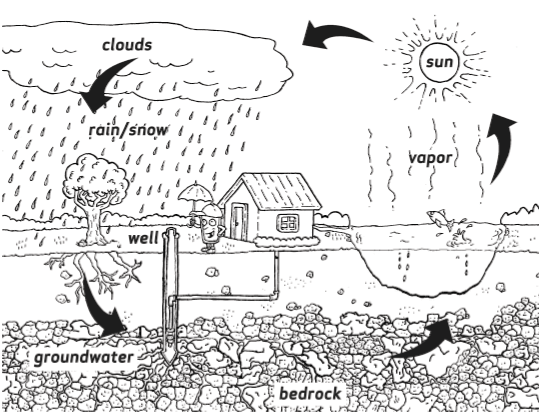
Click Here to learn more about the Earth's water cycle.
Why do we have seasons?
As the Earth spins on its axis, producing night and day, it also moves about the Sun in an elliptical (elongated circle) orbit that requires 365 1/4 days to complete. The Earth's axis is tilted at 23.5 degrees and is why we have seasons. When the Earth's axis points towards the Sun, it is summer for that hemisphere. When the Earth's axis points away, winter can be expected.

What is the significance of the Sun to the Earth?
Without the Sun, there would be no weather. Earth is positioned as the third planet, so our temperatures are sustainable for life. The average temperature of Mars is much colder, while Venus is much hotter.
How can you tell what time it is by looking at the Sun?
Because the sun ALWAYS rises in the east and sets in the west, you can tell the time just by looking at where the sun is. When you look east and the sun is on the horizon that means its approximately 6:00am. When the sun is directly above your head that means its noon. When you look to the west and the sun is on the horizon that means its approximately 6:00pm.

Why do we get more sunlight in the summer than in the winter?
You might not have noticed this, but the Earth tilts over slightly. If you have a globe at home or in school, you can see that the line between north and south poles, that goes through the center of the Earth, isn't vertical. It's actually tilting over by about 23 degrees. In our summer, the north pole is pointing towards the Sun so the Sun rises and sets roughly from due east to due west. In winter, the Earth is on the other side of the Sun so the North Pole is pointing away from the Sun. This means the Sun rises and sets more towards the southeast and southwest. You might notice this as you look out of the window. Think back to how high in the sky the sun was during the summer. Compare this to where the sun is during the winter and you'll see it's much lower down towards the horizon. Because the sun is lower down on the horizon, there's less time for it to travel between horizons. There's less distance for it to travel so the sun rises later and sets earlier meaning there's less daylight.
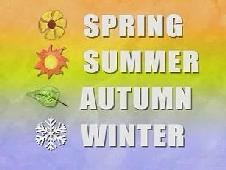
What is the purpose of the Moon?
The tidal effect of the moon helps to recirculate the oceans and keep them from becoming stagnated. The result of which would be catastrophic for advanced forms of life like humans.
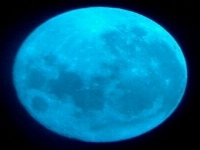
Why do the leaves change color?
During the spring and summer the leaves have served as factories where most of the foods necessary for the tree's growth are manufactured. This food-making process takes place in the leaf in numerous cells containing chlorophyll, which gives the leaf its green color. Along with the green pigment are yellow to orange to red pigments as well. Most of the year these colors are masked by great amounts of green coloring. But in the fall, because of changes in the length of daylight and changes in temperature, the leaves stop their food-making process. The chlorophyll breaks down, the green color disappears, and the yellow to orange to red colors become visible and give the leaves part of their fall splendor. The best time to enjoy the autumn color would be on a clear, dry, and cool day.
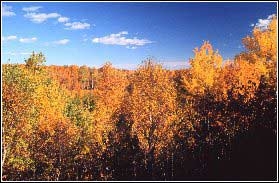
What is Climate Change?
Climate change represents a change in long-term weather patterns. They can become warmer or colder. Annual amounts of rainfall or snowfall can increase or decrease.
What is Global Warming?
Global warming refers to an average increase in the Earth's temperature, which in turn causes changes in climate. A warmer Earth may lead to changes in rainfall patterns, a rise in sea level, and a wide range of impacts on plants, wildlife, and humans. When scientists talk about the issue of climate change, their concern is about global warming caused by human activities. (Graphic Credit: World Almanac Education Group)


Is the Earth getting warmer?
Yes! The Earth has warmed by about 1ºF over the past 100 years. But why? Well, scientists are not exactly sure. The Earth could be getting warmer on its own, but many of the world's leading climate scientists think that things people do are helping to make the Earth warmer.
Click Here to learn more about Global Warming.
What is the Greenhouse Effect?
The greenhouse effect is the rise in temperature that the Earth experiences because certain gases in the atmosphere like water vapor, carbon dioxide, nitrous oxide, and methane trap energy from the sun. Without these gases, heat would escape back into space and Earths average temperature would be about 60ºF colder and would not be warm enough for humans to live. But if the greenhouse effect becomes stronger, it could make the Earth warmer than usual. (Graphic Credit: EPA)
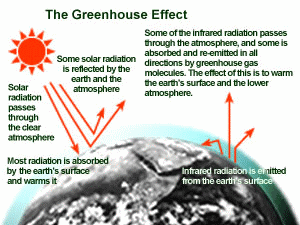
Global Warming may be a big problem, but can you make a difference?
Yes! There are several little things you can do to make a difference. Try carpooling. This will help reduce the amount of fossil fuels going into the atmosphere. Whenever you use electricity, you help put greenhouse gases into the air. Turning off lights, the television, and the computer when you are through with them. Also, planting trees is fun and a great way to reduce greenhouse gases. Trees absorb carbon dioxide, a greenhouse gas, from the air. Finally, don't forget about recycling.

What is El Niño?
El Niño is a climate pattern where the water in the Pacific Ocean near the equator gets hotter than usual and affects the atmosphere and weather around the world. El Niño climate conditions occur every few years, and they are not predictable. El Niño is Spanish for The Little Boy. It refers to the Christ child and was named by Mexican fisherman, who noticed the climate pattern often formed around Christmastime.
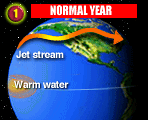 |
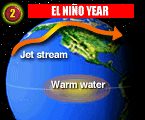 |
(Graphic Credit: USA TODAY) |
What type of a climate pattern do we see with an El Niño?
The climate pattern can change the weather of the United States, particularly in California and the southern states. Usually, El Niño brings more rain and higher temperatures. Also, warm ocean currents come farther north and all kinds of tropical fish can be caught in the waters far north along the United States West Coast. El Niño may also bring warmer than normal winter temperatures to the eastern part of the United States.
What is La Niña?
La Niña is sort of the opposite of El Niño. During a La Niña, the water in the same area along the equator gets colder than usual. This, too, affects weather around the globe and in the U.S. According to scientists, La Niña cycles generally create a more active hurricane season in the Atlantic.
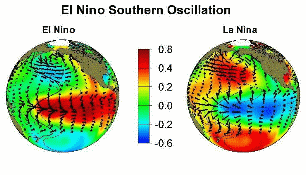
What type of climate pattern do we see with La Niña?
In the United States, La Niña is expected to bring above normal temperatures throughout most of the Southwest and southern Florida in the late summer and fall. These warmer conditions will extend across the Southeast during the winter months. Cooler than normal winter temperatures are expected in the Pacific Northwest. Cooler than normal temperatures are also expected across the Great Lakes and Northeast later in the winter into spring. In addition to temperature effects, La Niña is also expected to affect rainfall. Drier than normal conditions will persist in west Texas, New Mexico and Arizona into October. The late fall and early winter forecasts indicate continued dry conditions throughout much of the southern U.S. and into portions of the Midwest. Above normal precipitation is predicted for much of the Pacific Northwest throughout the fall and into the winter months, and in the Ohio and Tennessee River Valley in the winter.
What are the layers of the Earth's atmosphere?
The atmosphere is divided into five layers. It is thickest near the surface and thins out with height until it eventually merges with space.
Troposphere: The troposphere is the first layer above the surface and contains half of Earth's atmosphere. Weather occurs in this layer.
Stratosphere: The stratosphere is the second layer of the Earth's atmosphere. Many airplanes fly in the stratosphere, because it is very stable. Also, the ozone layer absorbs harmful rays from the Sun.
Mesosphere: The mesosphere is the third layer of the Earth's atmosphere. Meteors or rock fragments burn up in the mesosphere.
Thermosphere: The thermosphere is the fourth layer of the Earth's atmosphere. It's the layer with auroras and where the space shuttle orbits.
Exosphere: The exosphere is the fifth and last layer of the Earth's atmosphere. This is the layer where the atmosphere merges into space. This layer is extremely thin.
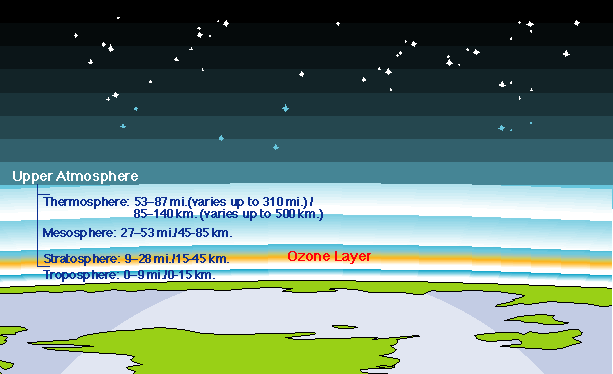
What is the tropopause?
The tropopause is the atmospheric boundary located between the troposphere and stratosphere. Going up from the surface, its the point where air ceases to cool with height and becomes almost completely dry.
What is ozone?
Ozone is a natural gas that is found in two different layers of the atmosphere. In the layer around the Earth's surface, otherwise known as the troposphere, bad ozone dirties the air and helps make smog. The troposphere extends up to the stratosphere layer, where good ozone protects life on Earth by absorbing some of the sun's UV rays. Stratospheric ozone is found most often between six to 30 miles above the Earth's surface.
What is the ozone layer?
The ozone layer forms a thin shield high up in the sky and is located in the stratosphere. It protects life on Earth from the sun's ultraviolet rays. In the 1980s, scientists began finding clues that the ozone layer was going away or being depleted. This allows more UV radiation to reach the Earth's surface. This can cause people to have a greater chance of getting too much UV radiation. Too much UV can cause bad health effects like skin cancer, eye damage, and get you sick easier.
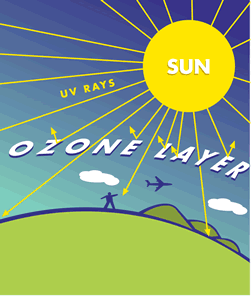
What is deforestation?
Deforestation is the cutting down large numbers of trees to use the land for something instead of a forest. Cutting down trees can affect the climate. After rain falls on a forest, mist rises and new rain clouds form. When forests are cut down, this cycle is disrupted, and the area eventually grows drier, causing a change in the local climate. If huge areas of trees are cut down, the carbon dioxide they would have used builds up in the atmosphere and contributes to the greenhouse effect. And without trees to hold the soil and absorb water, rain washes topsoil away, a process called soil erosion.
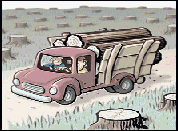 |
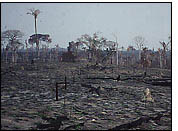 |
What is erosion?
Erosion is the wearing away of the land by water, ice or wind. Soil erosion is a natural process. It becomes a problem when human activity causes it to occur much faster than under natural conditions. Wind and water are the main agents of soil erosion.

What is acid rain?
Acid rain is rain, snow or fog that is polluted by acid in the atmosphere and damages the environment. Two common air pollutants acidify rain: sulphur dioxide and nitrogen oxide. When these substances are released into the atmosphere, they can be carried over long distances by prevailing winds before returning to earth as acidic rain, snow, fog or dust. When the environment cannot neutralize the acid being deposited, damage occurs.
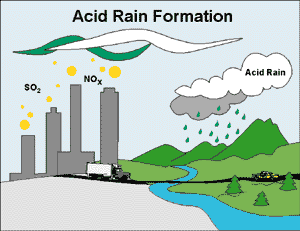
Lesson Plan: Here is a great lesson plan on El Niño. This lesson plan demonstrates the effects of El Niño, the trade winds, and upwelling.
Water Cycle Experiment: Here is a great experiment that teaches kids about how the water cycle works.
Acid Rain Experiment: Here is a great experiment on acid rain. It lets kids see how destructive acid rain can be to statue and buildings.
Ozone Pollution Science Fair Project: Here are some great science fair project ideas to help kids understand ozone pollution and makes them aware of how it is formed.
Greenhouse Effect Experiment: Here is an experiment that demonstrates how to recreate the greenhouse effect.
Global Warming Experiment: Here is an experiment investigates the effect on sea level due to the melting of floating ice due to global warming.
Science Fair Project Ideas: Here is a complete list of science fair project ideas. Discover the science behind the weather that impacts us every day.